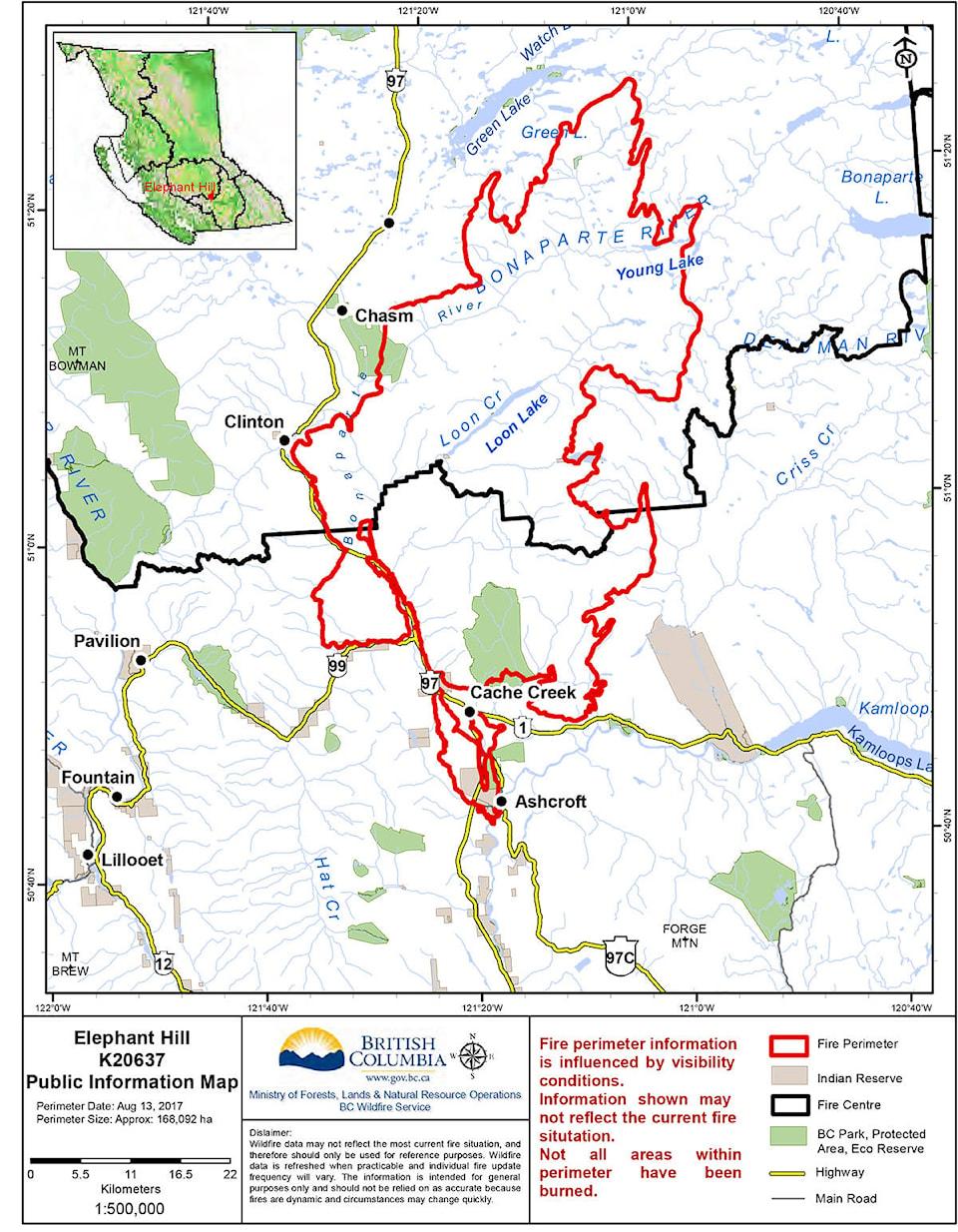9:15 p.m. update: “The good news is the fire didn’t grow today and there was some activity but not enough to test the perimeter of the fire,” says Noelle Kekula, Fire Information Officer on the Elephant Hill fire.
Crews worked hard at their objective, says Kekula, which was to strengthen and continue to build control lines.
The Elephant Hill fire also had air support today, after several days of disruption due to smoky conditions.
Crews are also continuing to work to access areas that have been affected by the wildfire.
“They are continuing to work with BC Hydro on those lines and then just getting those trees off the road and looking at what is out there. We hope to get the Regional District out sooner [rather] than later to start inventorying the properties that are out there.”
Over the next couple of days the weather is expected to co-operate, says Kekula.
“That is exactly what we can hope for, little wind — no gusts of wind is the way to say it — and lower temperatures and higher humidity,” she says.
While she says she understands people’s desire to go home and use the roads, she says it’s a matter of safety.
“It is a large active out of control fire,” she says.
“It’s the safety piece. It’s that human safety piece of it and until we are certain or have a high confidence that we’ve got a good secure line around those properties we would not recommend the [evacuation] order be downgraded.”
She says the BC Wildfire Service cannot recommend downgrades to orders if there is a chance the fire could reignite unburned fuels near people’s properties.
She also says that crews need to use the highways to travel, despite them being closed to public use.
“For all of our crews to go around a 160,000 hectare fire, we go on Highway 1 and we go through Highway 97 to go to the various parts of the fire. That is a fact. That is part of our fire fighting operations so we are using the roads to get to various parts of the fire,” she says.
“We are trying to ensure the safety of the people before they come back to their homes.”
Original story: The Elephant Hill fire is estimated at 168,092 hectares according to the latest BC Wildfire Service map.
“We finally are getting some better perimeter mapping from the weekend’s events, and so that’s where the growth is coming from,” says Fire Information Officer Noelle Kekula.
The map shows the fire’s growth pushing north to the Lake of the Woods next to Little Green Lake and having overcome Pressy Lake.
Some structures have been lost, says Kekula.
“What do we know about structure loss? What we know is yes, there were structures lost over the weekend. Where these structures were lost and how many, we don’t know because crews are trying to get into the areas right now so the regional district can get an inventory of what has occurred.”
Crews are currently in the process of trying to improve access to the impacted areas, says Kekula. Energized power lines, burnt trees and fallen trees are impeding the ways in..
When the regional district — in this case the Thompson-Nicola Regional District — is able to get in, they will be conducting an inventory of structures lost and will make contact with property owners.
Kekula emphasizes that even if a certain area is within the fire perimeter, it does not mean that area has burned.
“When we map it, we map the the perimeter of the fire,” she says. “There is a lot of unburnt fuel within those fires.”
The lines are also still an estimate “until we can get on the ground and get some accurate mapping, or in the air and get some better accurate mapping,” she says.
Due to winds over the weekend, the fire was able to jump guards that were in place on the northern flank of the fire.
“You build these control lines, you burn the area off, you think you’ve removed the fuel along the perimeter so if all those unburned fuels [between the guard and the fire] ignite, it won’t jump the control lines. But, the winds were such that it did jump the control line and it took a run to the north,” says Kekula. “That’s been the story of the summer. These winds that are making the fires and the dry, dry conditions. Dry conditions that we haven’t seen, if ever.”
Kekula does say that the rain over the weekend helped “without a doubt.”
“The rain, the cooler temperatures, the higher humidities, all of that definitely helped, but it also still is a 100-and-whatever-thousand hectare fire. It’s active. We don’t have much containment on it and so don’t let your guard down.”
She says that even last night, after the rains, on the drive from Cache Creek to Clinton she saw trees candling.
“It is still a very large active fire.”
Today, Kekula says that crews are using the rain to their advantage.
“We are building some control lines and we are extinguishing some hotspots and [doing] some mop up in certain areas,” she says. Direct attacks to get rid of hotspots are also happening.
“If you see a fire fighter thank them,” says Kekula. “Everyone is working hard, so thank them. We’re trying hard to get [people] back in their homes.”
